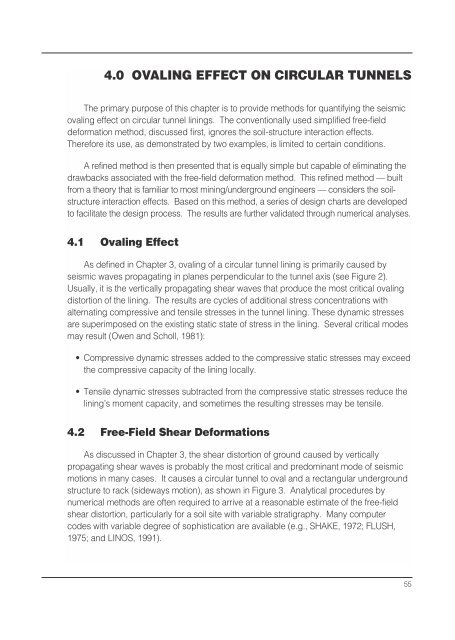Seismic Design of Tunnels - Parsons Brinckerhoff
Seismic Design of Tunnels - Parsons Brinckerhoff
Seismic Design of Tunnels - Parsons Brinckerhoff
You also want an ePaper? Increase the reach of your titles
YUMPU automatically turns print PDFs into web optimized ePapers that Google loves.
4.0 OVALING EFFECT ON CIRCULAR TUNNELS<br />
The primary purpose <strong>of</strong> this chapter is to provide methods for quantifying the seismic<br />
ovaling effect on circular tunnel linings. The conventionally used simplified free-field<br />
deformation method, discussed first, ignores the soil-structure interaction effects.<br />
Therefore its use, as demonstrated by two examples, is limited to certain conditions.<br />
A refined method is then presented that is equally simple but capable <strong>of</strong> eliminating the<br />
drawbacks associated with the free-field deformation method. This refined method — built<br />
from a theory that is familiar to most mining/underground engineers — considers the soilstructure<br />
interaction effects. Based on this method, a series <strong>of</strong> design charts are developed<br />
to facilitate the design process. The results are further validated through numerical analyses.<br />
4.1 Ovaling Effect<br />
As defined in Chapter 3, ovaling <strong>of</strong> a circular tunnel lining is primarily caused by<br />
seismic waves propagating in planes perpendicular to the tunnel axis (see Figure 2).<br />
Usually, it is the vertically propagating shear waves that produce the most critical ovaling<br />
distortion <strong>of</strong> the lining. The results are cycles <strong>of</strong> additional stress concentrations with<br />
alternating compressive and tensile stresses in the tunnel lining. These dynamic stresses<br />
are superimposed on the existing static state <strong>of</strong> stress in the lining. Several critical modes<br />
may result (Owen and Scholl, 1981):<br />
• Compressive dynamic stresses added to the compressive static stresses may exceed<br />
the compressive capacity <strong>of</strong> the lining locally.<br />
• Tensile dynamic stresses subtracted from the compressive static stresses reduce the<br />
lining’s moment capacity, and sometimes the resulting stresses may be tensile.<br />
4.2 Free-Field Shear Deformations<br />
As discussed in Chapter 3, the shear distortion <strong>of</strong> ground caused by vertically<br />
propagating shear waves is probably the most critical and predominant mode <strong>of</strong> seismic<br />
motions in many cases. It causes a circular tunnel to oval and a rectangular underground<br />
structure to rack (sideways motion), as shown in Figure 3. Analytical procedures by<br />
numerical methods are <strong>of</strong>ten required to arrive at a reasonable estimate <strong>of</strong> the free-field<br />
shear distortion, particularly for a soil site with variable stratigraphy. Many computer<br />
codes with variable degree <strong>of</strong> sophistication are available (e.g., SHAKE, 1972; FLUSH,<br />
1975; and LINOS, 1991).<br />
55
















